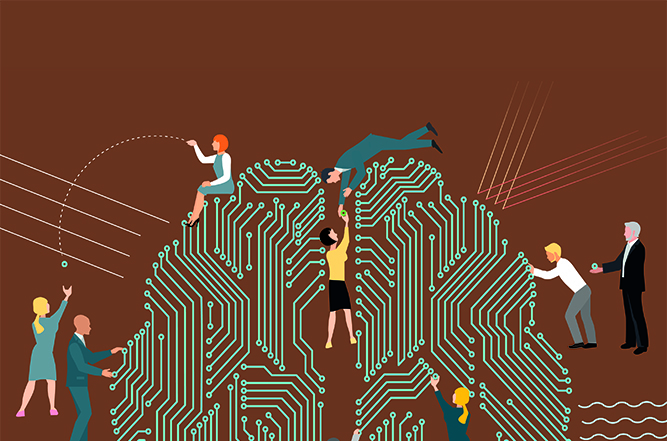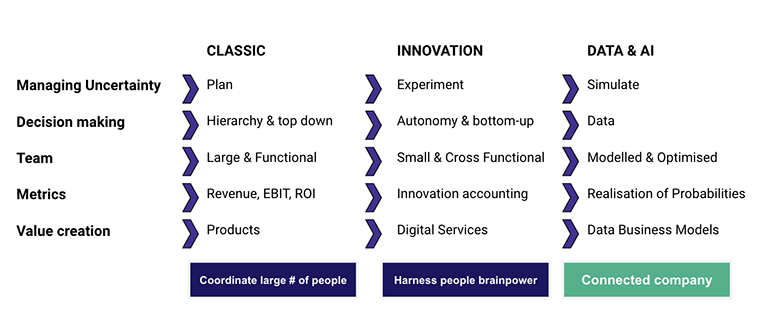Artificial intelligence is not (just) about automation but unprecedented connectivity within organizations. With artificial intelligence it is possible to make visible and even shape social networks and turn them into better performance and innovativeness.

The power of artificial intelligence to change our work, business and society is currently talked about predominantly in terms of increased automation and how it can increase productivity, but in our view, data and AI are delivering a new era for organizations.
Corporations were originally created to coordinate large numbers of people to work towards a common goal. Lately, they’ve become concerned with harnessing the brainpower of experts to create innovation. Over the last ten years, many organizations have invested in building innovation culture.

Over the last few years, working with our own holistic data and AI transformation at Futurice as well as that of our customers, we’ve realized the bigger and more radical change will take place in the area of connectivity. AI offers us unprecedented connectivity within organizations, across time horizons.
AI makes visible what was once vague, such as the impact of strategy on the daily work people do. AI allows us to make social networks visible and turn them into better performance. AI can take organizational knowledge and experience and turn them into accessible wisdom that helps you make better decisions today.
Let’s look at a few concrete examples.
Case Futurice–helping people connect
Knowledge work is hard. The core problem is that knowledge tends to dissipate. One of the goals of our own data and AI transformation is to make knowledge available. To that end, we’ve built solutions that increase connectivity within our organization.
To help everyone at Futurice better find the people they need when they need them, we created BubbleBurster3000, a search engine that uses the internal digital footprint of our employees–without using private data–to build a more holistic and real-time picture of people’s skills and interests than any standard HR solution is capable of. BB3K uses data that is produced as a by-product from other processes to uncover metaknowledge–that is, who’s been working with what.
Another way to make sure people have better access to knowledge is to actively encourage the growth of richer networks within our company. Lunch Roulette is a solution that finds a lunch companion who you haven’t had much interaction with previously–once again, based on your internal digital footprint.
Helping create connections between people makes our internal networks denser and information node points richer. We want to build organizational social capital and cohesion by helping people to get to know each other. This turns into speed and performance. Countless research studies have shown that social capital turns into intellectual capital and that knowledge work is very social.
Case Fira–improved situation awareness
The construction industry has many challenges related to productivity, quality and predictability. We see that major root cause of this is the lack of connectivity–design is disconnected from the construction phase. What really happens is disconnected from management’s perspective, different contractors are disconnected from each other, and one project is disconnected from the next one, so no learning takes place.
Fira has addressed one of the key topics, inadequate situation awareness, by combining different data sources, like scheduling, quality, environment, financial, and visual, into a holistic dashboard. This situational data is connected to higher-level key topics, like timetable data. The resulting awareness helps lead value drivers in a proper way. The situation awareness is shared all the way to the top: a part of the board report is generated directly from this data, once again building connections across organizational layers.
Why the connected company?
All earlier business theories and strategy frameworks have relied on a cascading value creation process–linear value chains, process optimization, coordinating functions. Consequently, the dominant organizational paradigm is driven by managing the complexity of large corporations via simplified and linear models. Why? Because no better approaches have been available.
Since then, we’ve learned that new business and profitable strategies are built on top of platforms, ecosystems and networks. Value chains still exist but not dominantly in a linear model. It all relies on connections and networks that drive value levers, such as client-centricity, across organizations.
Advancements in technology offer us the power of better data accessibility and handling, empowering us with new tools and shifting organizations towards connected companies.
The data and AI paradigm shift will force us to rethink organizational structures, processes and workflows, metrics, governance and decision-making, and, of course, culture. It’s about a lot more than just an increase in efficiency–it’s a systemic change.
The new type of connectivity into history, present and future that data and AI offer will deeply change our organizations. We will move from focusing on role-based thinking to contribution-based thinking. We are building much more responsive organizations. All-in-all systemic change transforms our operating model holistically, instead of improving individual processes.
The most radical level of the paradigm shift involves a change in the outward-facing part of the company’s business model, its offering: how it creates value and/or how it monetises value creation. We are talking about data-driven business models, data monetisation and outcome-based monetisation.
Each industry will manifest the change brought on by the paradigm shift in different ways. The future of organizations is a learning game and connectivity is a game changer.
The full version of this article will be published in Boardview magazine’s issue 1/2020 in June.



